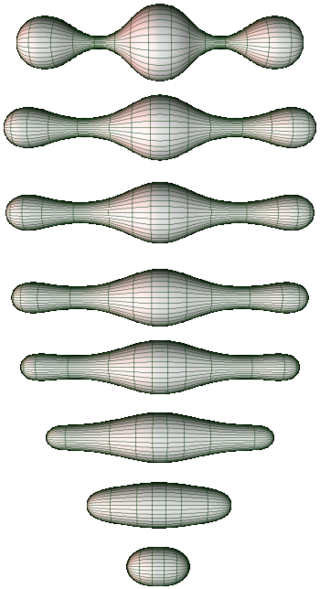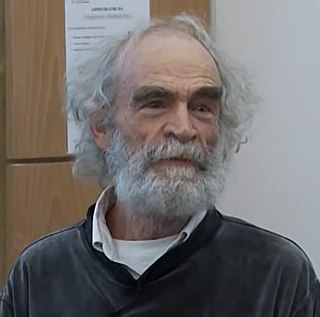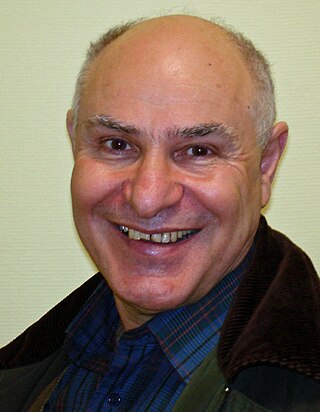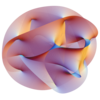Related Research Articles

In algebraic and differential geometry, a Calabi–Yau manifold, also known as a Calabi–Yau space, is a particular type of manifold which has properties, such as Ricci flatness, yielding applications in theoretical physics. Particularly in superstring theory, the extra dimensions of spacetime are sometimes conjectured to take the form of a 6-dimensional Calabi–Yau manifold, which led to the idea of mirror symmetry. Their name was coined by Candelas et al. (1985), after Eugenio Calabi who first conjectured that such surfaces might exist, and Shing-Tung Yau who proved the Calabi conjecture.
Riemannian geometry is the branch of differential geometry that studies Riemannian manifolds, defined as smooth manifolds with a Riemannian metric. This gives, in particular, local notions of angle, length of curves, surface area and volume. From those, some other global quantities can be derived by integrating local contributions.
In the mathematical field of Riemannian geometry, the scalar curvature is a measure of the curvature of a Riemannian manifold. To each point on a Riemannian manifold, it assigns a single real number determined by the geometry of the metric near that point. It is defined by a complicated explicit formula in terms of partial derivatives of the metric components, although it is also characterized by the volume of infinitesimally small geodesic balls. In the context of the differential geometry of surfaces, the scalar curvature is twice the Gaussian curvature, and completely characterizes the curvature of a surface. In higher dimensions, however, the scalar curvature only represents one particular part of the Riemann curvature tensor.

In the mathematical fields of differential geometry and geometric analysis, the Ricci flow, sometimes also referred to as Hamilton's Ricci flow, is a certain partial differential equation for a Riemannian metric. It is often said to be analogous to the diffusion of heat and the heat equation, due to formal similarities in the mathematical structure of the equation. However, it is nonlinear and exhibits many phenomena not present in the study of the heat equation.

Shing-Tung Yau is a Chinese-American mathematician. He is the director of the Yau Mathematical Sciences Center at Tsinghua University and Professor Emeritus at Harvard University. Until 2022 he was the William Caspar Graustein Professor of Mathematics at Harvard, at which point he moved to Tsinghua.
In the mathematical field of differential geometry, Ricci-flatness is a condition on the curvature of a (pseudo-)Riemannian manifold. Ricci-flat manifolds are a special kind of Einstein manifold. In theoretical physics, Ricci-flat Lorentzian manifolds are of fundamental interest, as they are the solutions of Einstein's field equations in vacuum with vanishing cosmological constant.

In differential geometry, the holonomy of a connection on a smooth manifold is a general geometrical consequence of the curvature of the connection measuring the extent to which parallel transport around closed loops fails to preserve the geometrical data being transported. For flat connections, the associated holonomy is a type of monodromy and is an inherently global notion. For curved connections, holonomy has nontrivial local and global features.
In differential geometry, a hyperkähler manifold is a Riemannian manifold endowed with three integrable almost complex structures that are Kähler with respect to the Riemannian metric and satisfy the quaternionic relations . In particular, it is a hypercomplex manifold. All hyperkähler manifolds are Ricci-flat and are thus Calabi–Yau manifolds.
In differential geometry, a G2 manifold is a seven-dimensional Riemannian manifold with holonomy group contained in G2. The group is one of the five exceptional simple Lie groups. It can be described as the automorphism group of the octonions, or equivalently, as a proper subgroup of special orthogonal group SO(7) that preserves a spinor in the eight-dimensional spinor representation or lastly as the subgroup of the general linear group GL(7) which preserves the non-degenerate 3-form , the associative form. The Hodge dual, is then a parallel 4-form, the coassociative form. These forms are calibrations in the sense of Reese Harvey and H. Blaine Lawson, and thus define special classes of 3- and 4-dimensional submanifolds.

Richard Streit Hamilton is an American mathematician who serves as the Davies Professor of Mathematics at Columbia University. He is known for contributions to geometric analysis and partial differential equations. Hamilton is best known for foundational contributions to the theory of the Ricci flow and the development of a corresponding program of techniques and ideas for resolving the Poincaré conjecture and geometrization conjecture in the field of geometric topology. Grigori Perelman built upon Hamilton's results to prove the conjectures, and was awarded a Millennium Prize for his work. However, Perelman declined the award, regarding Hamilton's contribution as being equal to his own.

Mikhael Leonidovich Gromov is a Russian-French mathematician known for his work in geometry, analysis and group theory. He is a permanent member of Institut des Hautes Études Scientifiques in France and a professor of mathematics at New York University.
Dominic David Joyce FRS is a British mathematician, currently a professor at the University of Oxford and a fellow of Lincoln College since 1995. His undergraduate and doctoral studies were at Merton College, Oxford. He undertook a DPhil in geometry under the supervision of Simon Donaldson, completed in 1992. After this he held short-term research posts at Christ Church, Oxford, as well as Princeton University and the University of California, Berkeley in the United States.

In mathematics, systolic geometry is the study of systolic invariants of manifolds and polyhedra, as initially conceived by Charles Loewner and developed by Mikhail Gromov, Michael Freedman, Peter Sarnak, Mikhail Katz, Larry Guth, and others, in its arithmetical, ergodic, and topological manifestations. See also a slower-paced Introduction to systolic geometry.
In differential geometry, a quaternion-Kähler manifold (or quaternionic Kähler manifold) is a Riemannian 4n-manifold whose Riemannian holonomy group is a subgroup of Sp(n)·Sp(1) for some . Here Sp(n) is the sub-group of consisting of those orthogonal transformations that arise by left-multiplication by some quaternionic matrix, while the group of unit-length quaternions instead acts on quaternionic -space by right scalar multiplication. The Lie group generated by combining these actions is then abstractly isomorphic to .
In differential geometry, a -structure is an important type of G-structure that can be defined on a smooth manifold. If M is a smooth manifold of dimension seven, then a G2-structure is a reduction of structure group of the frame bundle of M to the compact, exceptional Lie group G2.
The Geometry Festival is an annual mathematics conference held in the United States.
In the mathematical field of differential geometry, a calibrated manifold is a Riemannian manifold (M,g) of dimension n equipped with a differential p-formφ (for some 0 ≤ p ≤ n) which is a calibration, meaning that:
In mathematics, a nearly Kähler manifold is an almost Hermitian manifold , with almost complex structure , such that the (2,1)-tensor is skew-symmetric. So,

Edmond Bonan is a French mathematician, known particularly for his work on special holonomy.
References
- ↑ Bryant, Robert L. (1987) "Metrics with exceptional holonomy," Annals of Mathematics (2)126, 525–576.
- E. Bonan (1966), "Sur les variétés riemanniennes à groupe d'holonomie G2 ou Spin(7)", C. R. Acad. Sci. Paris, 262: 127–129.
- Bryant, R.L.; Salamon, S.M. (1989), "On the construction of some complete metrics with exceptional holonomy", Duke Mathematical Journal, 58 (3): 829–850, doi:10.1215/s0012-7094-89-05839-0 .
- Dominic Joyce (2000). Compact Manifolds with Special Holonomy. Oxford University Press. ISBN 0-19-850601-5.
- Karigiannis, Spiro (2009), "Flows of G2 and Spin(7) structures", Mathematical Institute, University of Oxford, 9 (4): 389–463.
